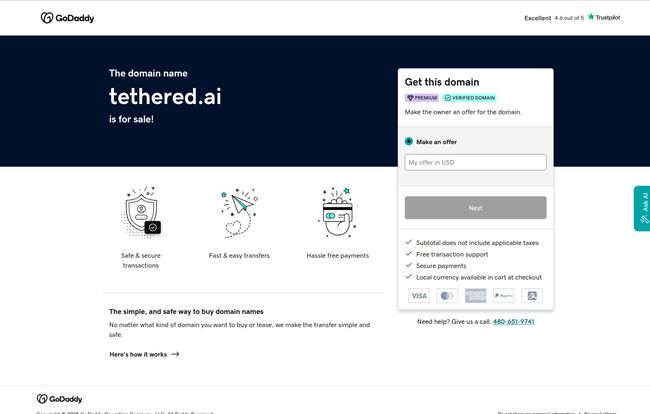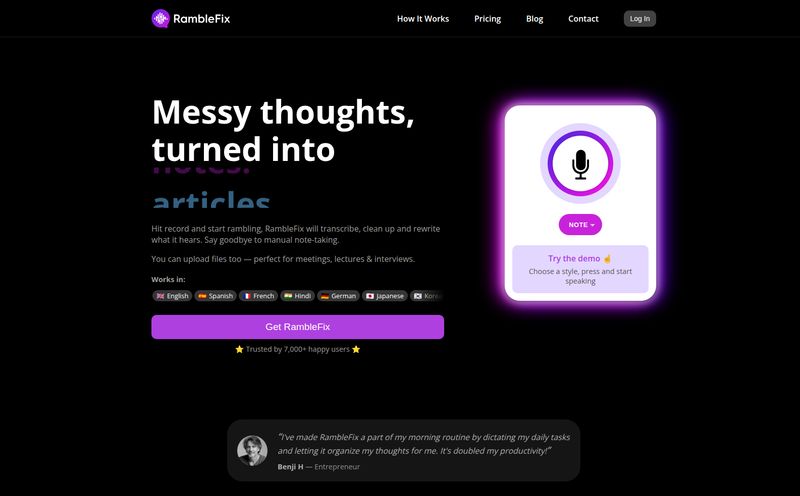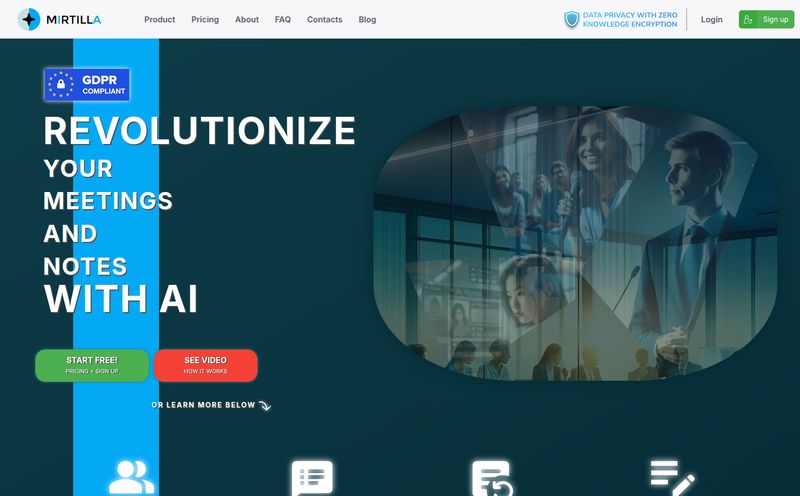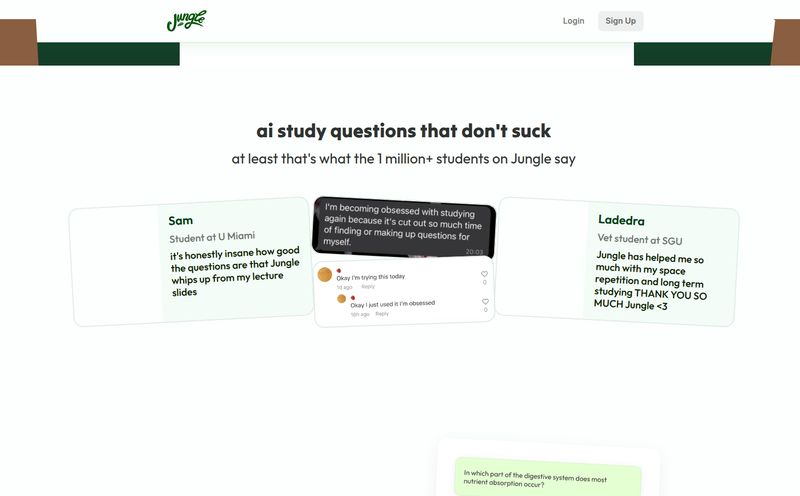As someone who’s been kicking around the SEO and digital marketing space for years, I've seen more tools come and go than I can count. It's a bit of a rollercoaster. You find something new, something that promises to fix that one annoying part of your workflow, you get excited, and then… poof. It vanishes. Sometimes with a bang, sometimes with a quiet whimper.
Today, I want to talk about one of those whimpers. A tool called Tethered AI.
I stumbled across it a while back and the concept immediately grabbed me. An AI-powered search assistant that takes notes for you while you browse. For a guy who lives in a state of perpetual 'tab hell' during research, this sounded like a dream. But when I went to check on it recently, I wasn't greeted by a slick landing page. I was greeted by a GoDaddy “For Sale” sign. Oof.
So what was Tethered AI, and what can its story tell us about the current AI gold rush? Let's get into it.
What Was the Big Idea Behind Tethered AI?
The pitch was simple and, honestly, brilliant. Tethered AI was designed to be your brain's best friend during web research. Instead of you having to frantically copy-paste snippets, juggle a dozen tabs, and try to distill complex articles into a messy Word doc, Tethered AI would do it for you. Automatically. It was meant to be a research sidekick, powered by the impressive brain of OpenAI’s GPT-3.

Visit Tethered AI
Imagine this: you're digging into keyword trends for a new client. You open an article from Search Engine Journal, another from Ahrefs, and a few niche blogs. As you scroll, a little AI assistant is working in the background, summarizing the key points, pulling out stats, and organizing it all into clean, concise notes. That was the promise. It aimed to turn the chaotic, messy process of online research into a streamlined, almost effortless activity. A real time-saver.
The Features That Made Me Say “Ooh, Shiny!”
Let's be real, most new tools are just a rehash of old ideas. But Tethered AI had a couple of features that felt genuinely fresh at the time.
Your Personal AI Research Secretary
The main draw was the automatic note-taking. This wasn't just a fancy bookmarking tool. It was about synthesis. By using GPT-3, it could understand the context of the page you were on and pull out the most relevant information. For anyone doing competitive analysis, content research, or even just trying to learn a new skill online, the value is immediately obvious. It's the difference between collecting a pile of bricks and having someone build a wall for you.
Wrangling the Chaos of Information
The other big benefit was the output: concise and organized notes. We've all been there. You spend three hours researching and end up with a notes file that looks like a ransom note. Tethered AI's goal was to give you a clean, readable summary you could actually use. This moves beyond simple data collection and into actual knowledge creation, which is the holy grail for a lot of us content folks.
"It felt like it was solving a problem everyone has but no one has quite cracked yet: making the firehose of internet information drinkable."
So, What Went Wrong? A Few Educated Guesses.
This is where we move from product review to digital forensics. Seeing that 'tethered.ai' domain up for sale is a pretty clear sign that things didn't go to plan. While I don't have a direct line to the founders, my years in this industry give me a few ideas about what likely happened.
The Double-Edged Sword of GPT-3
The very thing that made Tethered AI powerful was also its potential Achilles' heel. Relying on OpenAI's API is not cheap, especially at scale. Every time a user researched a page, Tethered AI would have to make an API call, and those calls add up. For a tool in beta, likely without a solid revenue stream, burning through cash on API costs is a quick path to an empty bank account. It's a common struggle for AI startups: your costs scale directly with user engagement, which is a tricky model to sustain without significant funding.
Drowned Out by the Big Guys?
The AI space is moving at a breakneck pace. In the time it takes for a small startup to get out of beta, a tech giant like Google or Microsoft can build a similar feature directly into their browser or search engine. With tools like Perplexity AI gaining massive traction and browsers like Arc and Edge integrating their own AI sidebars, the niche Tethered AI was targeting got very crowded, very quickly. It's tough for a small boat in a hurricane of tech Goliaths.
The Beta Trap
The info I found mentioned it was in beta. Sometimes, a product just never escapes the 'beta' phase. It could be due to persistent bugs, a lack of product-market fit, or the founders simply moving on to other projects. A great idea is one thing, but turning it into a stable, marketable product is a whole different ball game.
Are There Any Good Alternatives Still Standing?
Absolutely! The dream of an AI research assistant is alive and well. If the idea of Tethered AI appealed to you, here are a few tools that are actively developed and doing cool things in the same space:
- Perplexity AI: This is probably the closest direct competitor. It's an "answer engine" that searches the web and provides summarized answers with citations. It's incredibly powerful for getting quick, well-sourced information.
- Arc Browser: The browser from The Browser Company has a host of built-in AI features, including one that can "read" a page for you and provide a summary. It's a more integrated approach, baking the AI right into the browsing experience.
- Notion AI: If you're already using Notion for note-taking, its AI features are a no-brainer. You can paste a link and ask it to summarize the content directly within your notes, which is a pretty slick workflow.
While none of these are a perfect 1-for-1 replacement for the automatic background note-taking Tethered AI promised, they get you pretty close and solve many of the same pain points.
Lessons From a Digital Ghost
The story of Tethered AI, though short, is a classic cautionary tale for the modern tech world. It highlights the incredible potential of AI to solve real-world problems but also the immense challenges facing startups in this ridiculously competitive field. A cool idea and a powerful API aren't enough. You need a solid business model, a unique moat, and probably a bit of luck.
It's a reminder for us, the users, to hold our beta tools loosely. Get excited about innovation, for sure, but maybe don't build your entire business workflow around a product that hasn't proven its staying power. The AI graveyard is filling up fast, but for every tool that disappears, another, more resilient one often rises to take its place. And that's what keeps this space so darn interesting.
Frequently Asked Questions
What was Tethered AI?
Tethered AI was a planned AI-powered search assistant that used OpenAI's GPT-3. Its main purpose was to automatically take concise, organized notes for you as you browsed and researched on the web, saving time and simplifying complex topics.
Why isn't Tethered AI available anymore?
While there's no official statement, the fact that its domain name, tethered.ai, is for sale suggests the project is defunct. This could be due to a number of reasons common for startups, such as high operational costs (like GPT-3 API fees), intense competition from larger companies, or an inability to move from a beta version to a full product.
Was Tethered AI a free tool?
Information suggests Tethered AI was in a beta phase, and pricing details were never released. Many tools in beta are free to use initially to attract users and gather feedback, but the long-term pricing strategy was never made public.
What are the best alternatives to Tethered AI in 2024?
If you're looking for an AI research assistant, some of the best active alternatives include Perplexity AI (an answer engine), the AI features built into browsers like Arc and Microsoft Edge, and the AI capabilities within note-taking apps like Notion AI.
What is a GPT-3 powered search assistant?
It's a tool that uses OpenAI's GPT-3 language model (or newer versions like GPT-4) to enhance the web search and research process. Instead of just giving you a list of links, it can understand, summarize, and synthesize information from web pages to provide direct answers, notes, and insights.



